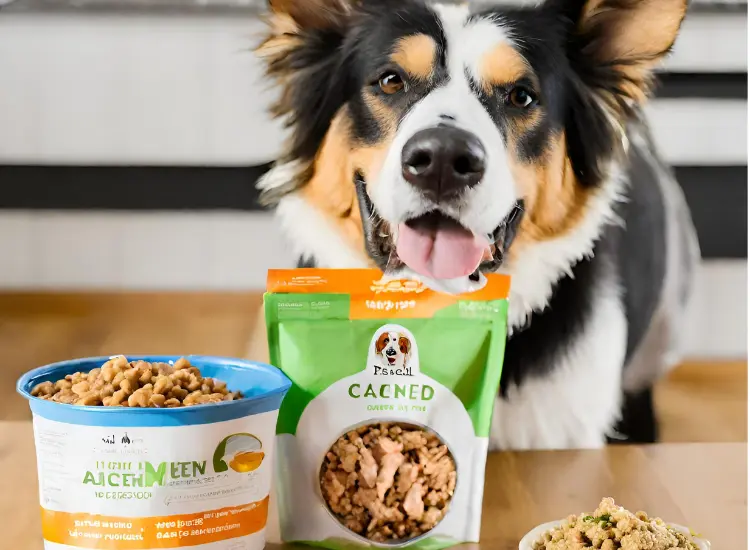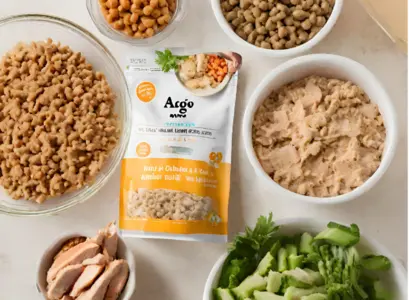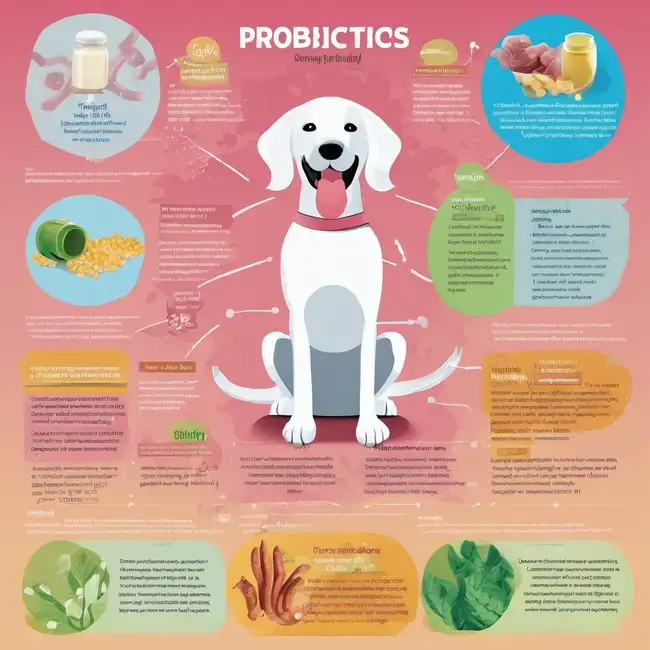What is Chicken Meal in Dog Food? Is it Good For Dogs?

- What is chicken meal in dog food?
- Is chicken meal good for dogs?
- Nutritional value of chicken meal in dogs
- Benefits of chicken meal in dog food
- Potential risks of chicken meal in dog food
- How to choose the best chicken meal for dogs
- Best dog food with chicken meal
- Is Chicken meal by product bad for dogs?
- Chicken and rice meal for dogs
- Common misconceptions about chicken meal in dog food
- Alternatives to chicken meal for dogs
- Resources
- Conclusion
- Frequently Asked Questions (FAQs)
This post may contain affiliate links, meaning I may earn a commission if you make a purchase, at no extra cost to you. I only recommend products I trust. Thank you for your support.
When pet owners scan the ingredients list of their dog’s food, “chicken meal” often pops up, sparking questions about its nature and nutritional value.
Chicken meal in dog food is made from rendered parts of the chicken, including flesh and skin, minus feathers, heads, feet, or intestines.
As a concentrated protein source, it promises numerous benefits for muscle growth and immune system support, yet it’s crucial to discern its quality, given the variations in sourcing and processing.
Distinguishing between chicken meal, chicken by-products, and “real chicken” becomes essential for informed choices regarding a dog’s diet.
This article addresses the question, what is chicken meal in dog food? and we explore the benefits and potential risks of chicken meal in your dog’s diet.
Sections will delve into the nutritional benefits and potential risks, assisting dog owners in identifying high-quality chicken meal.
Furthermore, we recommend the best dog foods with chicken meal on the market and address the common misconceptions of chicken meal in dog food.
What is chicken meal in dog food?
Chicken meal is essentially dried-out chicken meat ground into a powder, providing a concentrated and high-quality source of meat protein in dry dog foods.
Chicken meal, as a primary ingredient in many dog foods, is derived from chicken flesh, skin, and sometimes bone, which are ground down and rendered.
This process involves high temperatures and long cooking times, which dehydrate the material, making it a highly concentrated protein source.
The rendering process not only concentrates the protein but also ensures the elimination of bacteria, viruses, parasites, and other harmful organisms.
Despite these benefits, the quality of chicken meal can vary significantly depending on the source of the chicken used.
High-quality chicken meal is made from feed-grade chicken, which may include 4D meats. (meats from animals that are dying, deceased, disabled, or diseased)
Although this might raise concerns about quality, reputable dog food brands adhere to strict quality control measures to ensure the safety and nutritional integrity of the chicken meal used.

Is chicken meal good for dogs?
Yes, chicken meal is good for dogs. It is highly digestible and palatable, packed with essential nutrients like amino acids, vitamins, and minerals, which support strong bones, healthy skin and coat, and optimal organ function.
However, it’s important to consider the quality and sourcing of the chicken meal, as well as individual dog sensitivities.
Nutritional value of chicken meal in dogs
Chicken meal in dog food provides various nutritional benefits:
- Protein (Chicken meal contains up to 65% protein compared to regular chicken)
- Amino acids
- Vitamins (B6, B12, niacin)
- Minerals (phosphorus, zinc, selenium)
- Omega-6 fatty acids
- Glucosamine
- Bioavailable nutrients
Benefits of chicken meal in dog food
These are just a few benefits that chicken meal can offer when included in a dog’s diet:
1. Muscle development
The high protein of chicken meal in dog food content supports muscle development and maintenance, aiding in the strength and agility of dogs.
2. Digestibility
Chicken meal provides dogs with a highly digestible and bioavailable source of protein which is highly digestible, making it suitable for dogs with sensitive stomachs. Its digestibility ensures that dogs can efficiently absorb and utilize the nutrients.
3. Amino acids for optimal health
Chicken meal in dog food provides 10 out of the 22 amino acids, such as lysine and methionine that dogs are unable to synthesize on their own.
These amino acids are crucial for various physiological processes in dogs, including enzyme production, hormone synthesis, and immune function.
4. Nutrient-dense
Chicken meal in dog food is packed with high quality protein and essential nutrients that support the immune system of dogs, including vitamins, minerals, and antioxidants.
5. Improved coat and skin health
The protein and amino acids found in chicken meal in dog food can contribute to a healthy and shiny coat, as well as improve skin condition in dogs.
6. Enhanced energy levels
The high protein content in chicken meal in dog food provides dogs with the necessary energy to stay active and maintain a healthy weight.
7. Cost effective
Incorporating chicken meal in dog food can be cost effective while still providing high-quality protein, making it a practical choice for dog owners.
8. Palatability
Dogs generally find chicken meal appealing, making it an appetizing ingredient that encourages healthy eating habits.
9. Bone strength and dental health
Chicken meal in dog food is also beneficial for bone health due to its content of calcium and phosphorus, which are vital for the development and maintenance of strong bones and teeth.
10. Joint health and mobility
Glucosamine in chicken meal in dog food is known for its effectiveness in supporting joint function and mobility, which can be particularly beneficial for older dogs or breeds prone to joint issues.

Potential risks of chicken meal in dog food
While chicken meal in dog food can offer numerous benefits, it’s essential to be aware of potential risks associated with its use in dog food.
These risks can arise from various factors, including the quality of the chicken meal, the manufacturing process, and individual dog sensitivities.
Here are some potential risks of chicken meal in dog food to consider:
1. Lower nutritional value
The use of chicken meal in dog food may be a cost-effective measure, but it may not provide the same nutritional value as whole, fresh meat.
There could be a mix of 4D meats (those from chicken that are dead, dying, diseased, or disabled), which may not be very nutritious for dogs.
2. Loss of nutrients
The rendering process of chicken meal in dog food can lead to the loss of certain nutrients present in fresh chicken, impacting the final nutritional value of the chicken meal.
3. Allergies and sensitivities
Some dogs with chicken allergies may develop allergies or sensitivities to chicken meal, leading to symptoms such as itchy skin, red paw pads, yeasty ears, obsessive licking of paws, vomiting, and diarrhea, or other adverse reactions.
4. Contaminants and additives
Poor-quality chicken meal in dog food may contain contaminants, such as antibiotics, hormones, or heavy metals. Additionally, some dog food manufacturers may add artificial preservatives, flavors, or colors, which can be harmful to dogs.
5. Digestive issues
In some cases, dogs may have difficulty digesting chicken meal, leading to gastrointestinal problems like diarrhea, vomiting, or bloating.
6. Ethoxyquin
Chicken meal in dog food may contain the preservative ethoxyquin, which has been linked to certain health concerns in dogs. It’s important to choose dog foods that explicitly state the absence of this preservative.
How to choose the best chicken meal for dogs
When choosing dog food that contains chicken meal, it’s essential to research and select brands that prioritize transparency, quality, and safety in their ingredients and manufacturing processes.
Dog owners need to check that “chicken meal” is specified on the ingredient list and not just “meat meal,” which could be from any source and of variable quality.
Additionally, the placement of chicken meal near the top of the ingredient list indicates a higher proportion in the food, contributing to its overall nutritional value.
Here are some tips to help you choose the best chicken meal for dogs:
1. Quality ingredients
Ensure that the chicken meal is free from undesirable additives, preservatives, fillers, and by-products. High-quality chicken meal should be the predominant source of animal protein in the dog food.
2. Transparent labeling
Choose dog food brands that are transparent about the sourcing and processing of their ingredients. Reputable manufacturers provide information about the quality control measures and sourcing standards for their chicken meal.
3. Named protein source
Ensure that chicken meal is listed as a named protein source, such as “chicken meal,” rather than generic terms like “meat meal” or “animal meal,” which might be less indicative of quality.
4. Third-party certifications
Look for dog food that carries third-party certifications, such as those from the Association of American Feed Control Officials (AAFCO) or the National Animal Supplement Council (NASC). These certifications indicate that the food meets certain quality and safety standards.
5. Read reviews and seek recommendations
Research and read reviews from trusted sources, and consult with your veterinarian or other dog owners for recommendations on dog foods with chicken meal.

Best dog food with chicken meal
These products provide a variety of high-quality chicken meal for dogs to suit different dietary needs and preferences.
1. Nature’s Logic Canine Chicken Meal Feast
Nature’s Logic Canine Chicken Meal Feast is an all-natural, grain-free dog food that derives 85% of its protein from high-quality meat sources, with chicken meal as the first ingredient.
It contains no peas, potatoes, corn, wheat, or soy, and includes prebiotics and probiotics for dogs to support healthy digestion.
- Main ingredients: Chicken meal, chicken fat, spray-dried chicken liver, menhaden fish meal, and more.
- Texture: Dry kibble
- Protein Percentage: 43.5%
- Type: All-natural, grain-free, and gluten-free
2. Go! Carnivore Dry Dog Food
Go! Carnivore Chicken, Turkey, and Duck Adult is a highly recommended, grain-free dog food that derives the majority of its animal protein from chicken, turkey, and salmon meals.
It is free of GMO ingredients and is loaded with meat, making it a rare find in the market. Positive buyer reviews have highlighted its benefits.
- Main ingredients: Chicken meal, turkey meal, salmon meal, de-boned chicken, de-boned turkey
- Texture: Dry
- Protein Percentage: 34%
- Type: Grain-free
3. Wellness Complete Health Grain Free
Wellness Complete Health formula derives the bulk of its meat protein from chicken and chicken meal, making it one of the best grain-inclusive kibbles on the market.
It has garnered high recommendations and has been well-received by buyers, with positive feedback on its quality ingredients.
- Main ingredients: Deboned chicken, chicken meal, oatmeal, ground barley, peas
- Texture: Dry
- Protein Percentage: 27%
- Type: Grain Free
4. Taste of the Wild Dry Dog Food
Taste of the Wild provides a top-rated, nutrient-balanced formula at an affordable price.
It has been highly recommended for dogs, with positive buyer reviews highlighting its effectiveness in addressing sensitive stomach and skin issues in dogs.
- Main ingredients: Duck meal, chicken meal, sweet potatoes, peas, chicken fat
- Texture: Dry
- Protein Percentage: 36%
- Type: Grain-free
Is Chicken meal by product bad for dogs?
No, chicken meal by product is not necessarily bad for dogs. By-products can include organs, bones, and other parts of the chicken, which can provide additional nutrients.
However, the quality and sourcing of the by-products are essential factors to consider. Opting for high-quality dog foods that clearly specify the use of premium by-products can ensure a nutritious meal for your dog.
Chicken and rice meal for dogs
Chicken and rice is often recommended by veterinarians for dogs with sensitive stomachs or dietary restrictions, as it is relatively gentle on the digestive system.
This combination is highly digestible and low in fat, making it ideal for easing the gastrointestinal tract during recovery.
The simplicity of the ingredients also ensures that it is gentle on a dog’s stomach, providing a comforting meal that can help them regain their appetite and strength.
Preparation and feeding guidelines
- Protein Source: Opt for boneless, skinless chicken breasts as they are lean and easy on the stomach.
- Rice Selection: Use long-grain white rice, which is easier to digest than brown rice. Ensure it is well-cooked to avoid any digestive upset.
- Cooking Method: Avoid adding fats, oils, or seasonings which can irritate a dog’s stomach. Both chicken and rice should be cooked plainly.
- Feeding Advice: Initially, small, frequent meals are recommended to not overwhelm the dog’s digestive system. Gradually increase portion sizes as their condition improves.
Despite its benefits for temporary dietary needs, it’s crucial to understand that a diet solely consisting of chicken and rice lacks certain essential nutrients.
Dogs require a balanced diet enriched with various proteins, carbohydrates, fats, vitamins, and minerals to maintain optimal health. Long-term reliance on just chicken and rice could lead to nutritional deficiencies.
Therefore, while it’s a great choice for recovery periods, it’s important to reintegrate a complete and balanced diet, possibly supplemented with vitamins and minerals, as advised by a veterinarian.
Common misconceptions about chicken meal in dog food
Despite its nutritional benefits, chicken meal in dog food has been surrounded by various misconceptions.
Here are some common misconceptions clarified:
1. Chicken meal is not the same as chicken by-products
Chicken meal in dog food is derived from chicken flesh and skin, while by-products can include other parts of the chicken, such as organs or bones.
2. Chicken meal is a concentrated protein source
Contrary to some beliefs, chicken meal is not a filler ingredient but rather a rich source of essential amino acids and nutrients.
3. Chicken meal is not the sole determinant of a dog food’s quality
While the presence of chicken meal in dog food can indicate a higher protein content, it’s important to consider the overall quality of the dog food, including other ingredients and manufacturing standards.
Alternatives to chicken meal for dogs
If your dog has specific dietary restrictions or preferences, or you simply want to explore alternative protein sources, there are several options to consider.
Here are some alternatives to chicken meal in dog food:
- Broccoli: Rich in vitamins, minerals, and fiber, broccoli can be a nutritious addition to your dog’s diet.
- Salmon: Packed with omega-3 fatty acids, salmon provides numerous health benefits for dogs, including promoting a healthy coat and supporting joint health.
- Bananas: A great source of potassium and natural sugars, bananas can make a tasty and nutritious treat for dogs.
- Pineapple: With its high vitamin C content and enzymes, pineapple can aid in digestion and provide additional nutrients.
- Shrimp: Shrimp is a lean protein source that can provide dogs with essential amino acids and minerals like selenium.
- Cantaloupe: This fruit is low in calories and high in vitamins A and C, making it a refreshing and healthy snack for dogs.
- Tuna: Tuna is a good source of lean protein and omega-3 fatty acids, which can support heart and brain health in dogs.
- Celery: Low in calories and high in fiber, celery can be a crunchy and nutritious addition to your dog’s diet.
- Cauliflower: Rich in antioxidants and fiber, cauliflower can provide dogs with essential nutrients and support their digestive health.
- Olive Oil: A drizzle of olive oil can add healthy fats to your dog’s diet and support their coat and skin health.
- Peas: Peas are a good source of plant-based protein, fiber, and essential vitamins and minerals.
- Rice: Rice is an easily digestible carbohydrate source that can provide dogs with energy and help regulate digestion.
Resources
- Association of American Feed Control Officials
- Pet Food Institute – Understanding pet food labels
- Purina: What is chicken meal in dog food?
Conclusion
Chicken meal can be a valuable ingredient in dog food, providing dogs with essential protein, amino acids, vitamins, and minerals.
Chicken meal in dog food offers numerous benefits, including improved muscle development, coat and skin health, energy levels, and dental health.
However, it’s crucial to choose high-quality dog food with transparent sourcing and manufacturing processes to ensure the best nutritional value for your furry friend.
While chicken meal is generally considered good for dogs, individual sensitivities, and the quality of the chicken meal should be taken into account.
Consulting with some of the best veterinarians in your area can help determine if chicken meal is suitable for your dog’s specific dietary needs.
Other trending articles:
- Is raw chicken good for dogs?
- How to comfort a dog with pancreatitis
- The menopause diet 5 day plan
- 90-30-50 diet plan 7-day meal plan to lose weight
- 7-day bone broth diet plan
- Caretaker vs caregiver description
- Can dogs eat acorns?
- Christmas party buffet food ideas
Frequently Asked Questions (FAQs)
Is chicken meal bad for dogs?
No, chicken meal is not inherently bad for dogs. It can provide essential protein and nutrients. However, individual dog sensitivities and the quality of the chicken meal should be considered.
Is chicken meal good for dogs with sensitive stomachs?
Yes, chicken meal can be beneficial for dogs with sensitive stomachs, as it is a relatively gentle protein source. However, individual sensitivities may vary, and consulting with a veterinarian is recommended.
What are some ingredients to avoid in dog food?
When choosing dog food, it’s best to avoid certain ingredients that may be harmful to your pet. These include:
1. Corn and wheat gluten.
2. Chemical preservatives like BHA and BHT.
3. Ethoxyquin.
4. Artificial food dyes (Blue 2, Red 40, Yellow 5 and 6, 4-MIE).
5. Rendered fats.
Why is chicken meal used in Science Diet dog food?
Science Diet includes chicken meal because it is a meat concentrate that offers nearly 300% more protein than fresh chicken, making it a highly nutritious addition.
Following chicken meal, pork fat, also known as lard, is used to enhance the flavor, appealing to dogs’ taste buds.
Should I choose dog food with chicken meal as the first ingredient?
While chicken meal as the first ingredient can indicate a higher protein content, it’s crucial to consider the overall quality of the dog food, including other ingredients and manufacturing standards.




